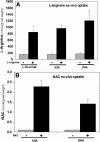Topical application of L-arginine blocks advanced glycation by ascorbic acid in the lens of hSVCT2 transgenic mice
- PMID: 21897744
- PMCID: PMC3164690
Topical application of L-arginine blocks advanced glycation by ascorbic acid in the lens of hSVCT2 transgenic mice
Abstract
Purpose: Previous experiments from our laboratory showed that the oral intake of selected guanidino compounds could block the formation of crystallin-bound advanced ascorbylation products. Here we tested whether these were also active when applied as eye drops.
Methods: Two month old hSVCT2 transgenic mice (n=10) were treated twice daily with one drop of 0.1% L-arginine, γ-guanidinobutyric acid (GBA), penicillamine (PA) or N-acetylcysteine (NAC) in one eye and vehicle only in the other eye. After seven months, lens crystallins were isolated, dialyzed, and proteolytically digested to determine the protein-bound fluorescence at 335/385 and 370/440 nm excitation/emission and the advanced glycation/ascorbylation endproducts carboxymethyl-lysine (CML), carboxyethyl-lysine (CEL), glucosepane, glyoxal, and methylglyoxal hydroimidazolones G-H1 and MG-H1. The topical uptake of L-arginine and NAC was also evaluated in vitro and in vivo in rabbit lens.
Results: In hSVCT2 mice, L-arginine decreased 335/385 and 370/440 nm fluorescence by 40% (p<0.001), CML, CEL, and glucosepane crystallin crosslinks by 35% (p<0.05), 30% (p<0.05), and 37% (p<0.05), respectively, without affecting MG-H1 and G-H1. NAC decreased 335/385 nm fluorescence by 50% (p<0.001) but, like PA and GBA, had no effect on other modifications. L-Arginine uptake into rabbit eyes treated topically reached identical lenticular plateau levels (~400 nmol/g wet weight) at 0.5% and 2.0% but levels remained three times higher at 5 h at 2% versus 0.5% concentration, respectively. In vitro studies showed a 100 fold higher L-arginine level than NAC levels, implicating high affinity uptake of the former.
Conclusions: L-Arginine when applied both orally and topically is a potent and broad suppressor of advanced ascorbylation in the lens. Its uptake in rabbit lens upon topical application suggests transcorneal uptake into the human lens should be feasible for testing its potential anticataract properties in clinical trials.
Figures





Similar articles
-
Protein posttranslational modification (PTM) by glycation: Role in lens aging and age-related cataractogenesis.Exp Eye Res. 2021 Sep;210:108705. doi: 10.1016/j.exer.2021.108705. Epub 2021 Jul 20. Exp Eye Res. 2021. PMID: 34297945 Free PMC article. Review.
-
Inhibition of crystallin ascorbylation by nucleophilic compounds in the hSVCT2 mouse model of lenticular aging.Invest Ophthalmol Vis Sci. 2008 Nov;49(11):4945-52. doi: 10.1167/iovs.08-1813. Epub 2008 Apr 17. Invest Ophthalmol Vis Sci. 2008. PMID: 18421088 Free PMC article.
-
Transition metal-catalyzed oxidation of ascorbate in human cataract extracts: possible role of advanced glycation end products.Invest Ophthalmol Vis Sci. 2000 May;41(6):1473-81. Invest Ophthalmol Vis Sci. 2000. PMID: 10798665
-
Vitamin C mediates chemical aging of lens crystallins by the Maillard reaction in a humanized mouse model.Proc Natl Acad Sci U S A. 2006 Nov 7;103(45):16912-7. doi: 10.1073/pnas.0605101103. Epub 2006 Oct 30. Proc Natl Acad Sci U S A. 2006. PMID: 17075057 Free PMC article.
-
Telomere Attrition in Human Lens Epithelial Cells Associated with Oxidative Stress Provide a New Therapeutic Target for the Treatment, Dissolving and Prevention of Cataract with N-Acetylcarnosine Lubricant Eye Drops. Kinetic, Pharmacological and Activity-Dependent Separation of Therapeutic Targeting: Transcorneal Penetration and Delivery of L-Carnosine in the Aqueous Humor and Hormone-Like Hypothalamic Antiaging Effects of the Instilled Ophthalmic Drug Through a Safe Eye Medication Technique.Recent Pat Drug Deliv Formul. 2016;10(2):82-129. doi: 10.2174/1872211309666150618104657. Recent Pat Drug Deliv Formul. 2016. PMID: 26084629 Review.
Cited by
-
Minimizing Oxidative Stress in the Lens: Alternative Measures for Elevating Glutathione in the Lens to Protect against Cataract.Antioxidants (Basel). 2024 Oct 1;13(10):1193. doi: 10.3390/antiox13101193. Antioxidants (Basel). 2024. PMID: 39456447 Free PMC article. Review.
-
Glucosepane: a poorly understood advanced glycation end product of growing importance for diabetes and its complications.Clin Chem Lab Med. 2014 Jan 1;52(1):21-32. doi: 10.1515/cclm-2013-0174. Clin Chem Lab Med. 2014. PMID: 23787467 Free PMC article. Review.
-
Elucidating the Antiglycation Effect of Creatine on Methylglyoxal-Induced Carbonyl Stress In Vitro.Int J Mol Sci. 2024 Oct 10;25(20):10880. doi: 10.3390/ijms252010880. Int J Mol Sci. 2024. PMID: 39456665 Free PMC article.
-
Protein posttranslational modification (PTM) by glycation: Role in lens aging and age-related cataractogenesis.Exp Eye Res. 2021 Sep;210:108705. doi: 10.1016/j.exer.2021.108705. Epub 2021 Jul 20. Exp Eye Res. 2021. PMID: 34297945 Free PMC article. Review.
-
Revisiting amino acids and peptides as anti-glycation agents.Medchemcomm. 2018 Feb 12;9(4):614-624. doi: 10.1039/c7md00514h. eCollection 2018 Apr 1. Medchemcomm. 2018. PMID: 30108952 Free PMC article. Review.
References
-
- Cheng R, Feng Q, Argirov OK, Ortwerth BJ. Structure elucidation of a novel yellow chromophore from human lens protein. J Biol Chem. 2004;279:45441–9. - PubMed
-
- Cheng R, Lin B, Lee KW, Ortwerth BJ. Similarity of the yellow chromophores isolated from human cataracts with those from ascorbic acid-modified calf lens proteins: evidence for ascorbic acid glycation during cataract formation. Biochim Biophys Acta. 2001;1537:14–26. - PubMed
Publication types
MeSH terms
Substances
Grants and funding
LinkOut - more resources
Full Text Sources
Medical
Molecular Biology Databases
